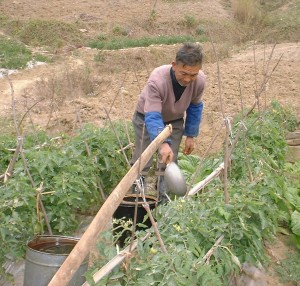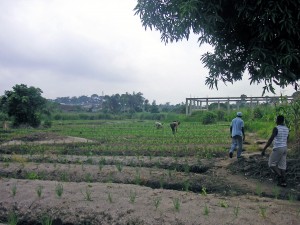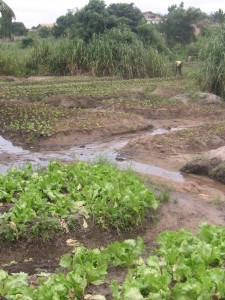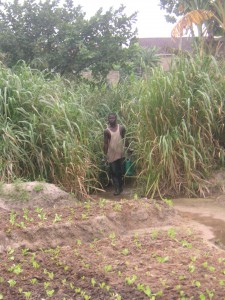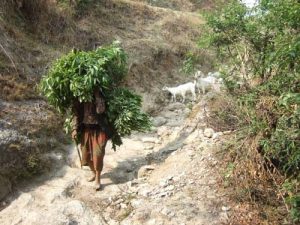There are at least 50 million poor farmers who use sprinkling cans to irrigate quarter acre vegetable plots and sell what they grow to customers in cities and towns in Asia and Africa.
I have interviewed hundreds of them, and have no doubt that they can double or triple their incomes with access to improved affordable irrigation, farming methods, and access to markets.
Here is a case in point.
In August, 2009, Bob Nanes, (IDE Ghana), Sue Haley (IDE Africa) and I visited 14 sprinkling can farmers who produce
vegetables for the million or so people who live in Kumasi, Ghana.
Here’s what we learned.
Kumasi bucket farmers typically grow vegetables in swampy runoff areas that are too wet to build houses on.
They first cleared the land, and then built 1.5 ft deep hand dug drainage ditches, running on both sides of 3.5 ft wide raised beds, to drain the bogs
where they grow vegetables.
Irrigating by bucket is extremely labor intensive. To irrigate a quarter acre plot, a farmer has to spend seven hours a day every day to fill his sprinkling cans from a waterhole, carry the water to the raised beds, and then sprinkle the vegetables.
If they chose to hire labor to do this work, the going rate amounts to $50 (US) a month, or $150 for the three month dry season when vegetables command the highest price.
They sell their vegetables to wholesalers, usually women, who buy a whole raised bed of vegetables at a time and sell them to market stalls in Kumasi. Farmers earn $2-$6/day over the three months of the dry season for their work, and earn additional smaller income by growing vegetables outside of the dry season.
Doubling the Incomes of Kumasi Bucket Farmers
The key constraint to improving the livelihoods of the bucket farmers we talked with was the incredible labor requirements of sprinkling can irrigation.
There seems to be a fairly simple solution to this.
A simple quarter-acre low cost drip system with a gravity tank installed at the water source would cut the labor requirements from seven hours to one hour a day. The farmer would lift the water to fill the water gravity tank, and the drip system takes care of everything else, delivering the water uniformly to the plants. The $100 investment in the drip system would be repaid two or three times over in the first growing season from the savings in labor and improved crop yield and quality. After the first year, the farmer could use some of the profits to buy a treadle pump to lift water into the gravity tank, reducing labor costs even more.
Access to more land is available. With reduced labor costs, farmers told us they could either rent more land where they were already farming or further out from the city, where land is cheaper. The demand for vegetables in Kumasi far outstrips the supply. With the same7 hours of labor a day, they could produce vegetables on three times as much land, and triple both their crop and income in the dry season.
The same kind of opportunity exists for the 10 million or so sprinkling can farmers all over Sub Saharan Africa. In each location, sprinkling can farmers can take advantage of a different group of opportunities, depending on their circumstances. One group might double their income by using treadle pumps, another from better fertilizer, seeds and farming practices, and others might see their incomes grow from improved direct access to vegetable buyers.
Diagram of Low Cost Drip System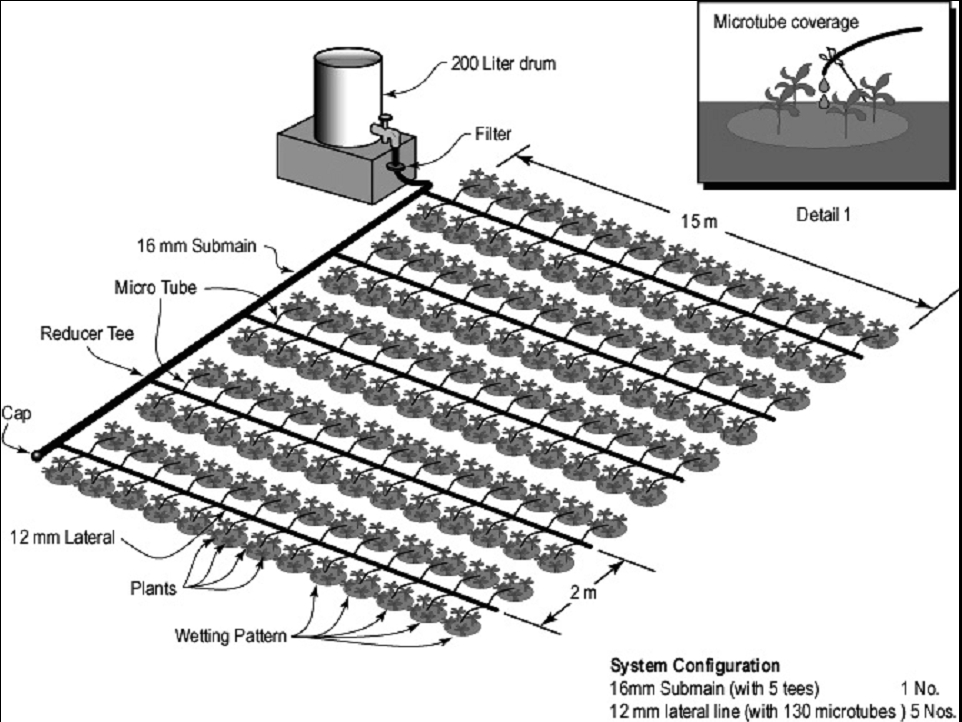
The opportunities are limitless. The only thing that stands in the way of new found prosperity for sprinkling can farmers is limited access to affordable improved irrigation, farming and markets, and our continuing blind arrogance and ignorance about poverty at the grass roots.
How Sprinkle Can Farmers and 700 million Farmers like Them can move out of Poverty

